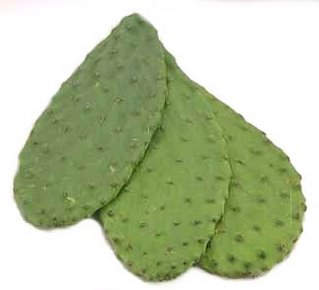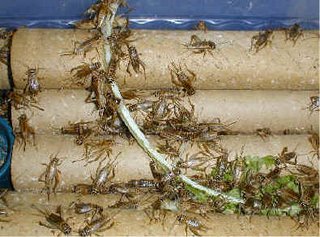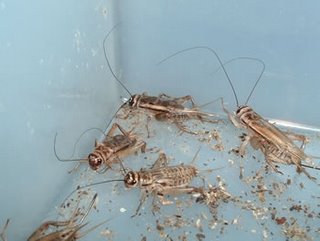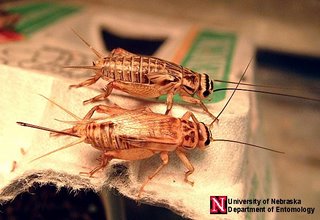 Introduction
Introduction
The house cricket (Achetus domesticus) is a staple and nutritious food for many herp species. Obtaining a reliable supply of these insects can be a bother, especially if one requires a constant supply of newly hatched 'pinhead' crickets, to say nothing of the costs of feeding a large collection with pet-shop-bought crickets. The following article outlines a method for cricket raising which has been developed over the past two years in order to provide a collection of frogs (Mantellas, Discophus, and Dendrobates) with a constant supply of small and large crickets. There are several things to consider before you decide to raise crickets:
-
The crickets will make a lot of noise. You must have an area to keep them where this is not a problem.
-
Escapes will be inevitable! Eventually you might find yourself falling asleep (or not falling asleep) to the trill of a cricket courting in the warmth beneath an appliance in your room. If you live in an apartment your neighbors may find new, unwanted, tenants in the hallways. Commercial insecticide pellets such as those used to kill earwigs can be placed in the room with your cricket colony to prevent escapees from taking over the house.
-
Crickets have a definite odor, but if the colony is well maintained and kept clean, most people do not find it offensive. A major source of odor is the cotton wool in the water dishes which can quickly collect droppings so it must be kept clean. In the method described here, the main colony is kept dry (no damp substrate) which reduces the smell considerably.
One of the main problems encountered with most descriptions of cricket breeding is that the eggs hatch in the same container as the adult breeding colony, usually in a substrate placed on the bottom of the breeding enclosure. This requires one to sort the crickets before feeding to various sized animals. The breeding substrate also quickly becomes littered with dead crickets and droppings. It is also difficult to keep moist if egg cartons or other hiding material is placed on top of it.
The method described here provides a removable egg-laying container, separating the eggs and adults, thereby raising yields and providing crickets of various sizes. Depending on the number of crickets desired the system can be set up in the corner of a room or the bottom of a closet - space is not a major consideration. The cost to establish a basic system is about $30.00 plus the cost of the initial breeding colony of crickets. To start such a colony at least 200 crickets are required, and the colony should not be used for feeding until well established and your first babies are adult-sized. If you plan to use some of the crickets for feeding, a batch of 1000 can be purchased quite inexpensively from a cricket supplier.
Materials Required
The materials required for a basic setup are as follows:
-
2 Large Plastic storage containers - 'Rubbermaid' or similar (Breeding containers)
-
3 Medium sweater boxes (Rearing containers)
-
6 - 500 ml ( 1 pint) plastic tubs (Nesting and food containers)
-
egg 'flats'
-
Heat pad (optional) - medical types available at most drug stores work well
-
Water dispenser - small chick waterer available at feed shops or specialty pet shops.
-
Several jar lids
-
Quilt batting or plastic scouring pads
-
Aluminum mosquito screening
A Description of the Basic Setup
The breeding colony is housed in one of the deep (26" x 14" x 16" deep) plastic storage boxes with egg flats inserted vertically throughout except for about 6 inches at one end where the water dispenser is located. Other containers may be adapted for this use. No substrate of any kind is placed in the bottom of this container. Holes (4" x 4") are cut in opposite ends of the breeding container and covered with metal mosquito screening secured with duct tape, to provide ventilation. (Do not use fiberglass screening, the crickets will soon eat through it and escape! Catching 1000 crickets loose in your apartment is not a task I would recommend, although I have done it, once). The water dispenser is a commercial chick waterer which is essentially a plastic jar inverted over a circular trough which holds the water. Plastic scouring pads or Dacron quilt batting should be cut to fill the trough. They will soak up water, making it available to the crickets while preventing them from drowning. The egg flats should reach to within about 4" of the top of the container. On top of these are placed two plastic tubs, such as sour cream or yogurt is purchased in. One contains food and the other contains egg laying medium.(See specific sections for descriptions of each). A heat pad is placed on top of the lid of the storage box to provide adequate warmth. Crickets thrive at temperatures higher than the average house temperature. They prefer 80-90 degrees F (26-32 C). If you place them in a warm herp room this should provide them with enough heat. At lower temperatures they will survive and even breed, but yields will be much reduced. They also seem to live longer at lower temperatures, something to keep in mind if you find yourself with an excess which you want to keep alive as long as possible.
Maintenance of the breeding colony comprises of filling the food, keeping the nesting material damp and filling the water when empty. A 1 litre waterer will last 4-5 weeks. Every 2 months or so the entire colony and fixtures should be moved to the second container. The cricket waste and ex-crickets can then be dumped out of the first container and it can be washed. It is best to do this outside, if possible, as escapes are inevitable. Over time, cricket droppings will accumulate on the egg cartons and the cartons will need replacing. The egg cartons are most easily handled if they are glued together in sets of 4 or 5 for easy removal from the container.
Feeding
Feeding the crickets the right diet is important for two reasons. Firstly the crickets need adequate nutrition to survive and breed. Secondly, the nutrition from the crickets will be passed on to your reptiles or amphibians and so it is important to keep them healthy. Crickets require a high-protein diet. Without, and often with, an adequate diet the crickets will prey on each other.
Commercial cricket foods are available in large and small quantities. The large sacks of cricket chow may not be available everywhere, check with a local feedshop. The smaller jars of cricket food sold at pet shops are very expensive and I have heard mixed results about some brand's quality and acceptability to the crickets. Tropical fish flakes have also been recommended as food but the expense is astronomical if you are raising a large number of crickets.
As an alternative, I use the following recipe. It is inexpensive and several dollars worth will last several months or more, depending on the number of crickets you are producing. The same food is used for all sizes of crickets. The food is based on commercial dried cat food. In addition I provide a supplement of 10 parts skim milk powder (by volume) to 1 part of a good quality calcium supplement intended for reptiles and amphibians. The cat food is shaken in this mixture until coated and then given to the crickets. More supplement can be sprinkled onto the food as the crickets eat it. To provide a balanced diet this is supplemented with alfalfa pellets and, whenever available, raw vegetable scraps. Top up each as they are eaten. The food can be placed in a small plastic container on top of the egg cartons in the breeding container. Crickets can be removed and 'gut-loaded' with higher quality food several days prior to feeding them to your herps if desired. However, this diet has proved sufficient nourishment for the crickets used to feed a number of amphibians and several breeding groups of Dendrobatid frogs.
Breeding the Crickets
As long as the crickets have food, water and a high temperature they will breed profusely. Their natural nesting material is damp soil and so to duplicate this a 500ml (one pint) plastic tub full of moist nesting material is placed on top of the egg cartons in the breeding container. The nesting material can be damp sand, peat moss or my favorite 'turf'. 'Turf' or 'tuff' (it is similar to coarse bonsai soil) is a landscaping material consisting of small clay based pellets which retain water well. It does not mold as easily as peat moss.
Since the crickets have no other substrate in the cage, the crickets tend to burrow into the nesting medium and disturb the eggs. However, if it is packed gently, the crickets will only disturb the top ½" or so and lay their eggs below. Use a container at least 2-3" deep so the crickets can lay their eggs down below, where they will not be disturbed. One or more of these containers can be placed in with the crickets. No matter how many containers of nesting material are placed in the container, the crickets will inevitably lay some eggs around the water dish. These generally will not hatch.
The nesting material requires constant attention. It must be checked every few days and sprayed if dry. Peat will need to be checked far more frequently than 'turf'. The nesting material can dry rapidly due to the heat pad above it. Once a batch of eggs is completely desiccated it is useless.
After 4-7 days the nesting material will be positively packed with oblate white eggs positioned vertically about 1-2" below the soil surface. The nesting dish should then be removed and incubated.
Incubation of the Eggs
To incubate the eggs, the original lid is placed on the nesting container and it is placed on the heat pad on top of the breeding container. In about 7-10 days it will be swarming with pinhead crickets and should then be moved to a rearing container. At this time, the nesting container in with the breeding colony can be removed and replaced with a new one.
Rearing the Babies
Once the eggs begin to hatch, the nesting container is moved to a small sweater box (16" x 8" x 4"). The lid of this should have holes drilled into it about 1" apart. There is little chance that the baby crickets will escape en masse through the holes, the boxes are usually too slippery for them to climb and they have little interest in leaving the food and warmth at the bottom of the container. If there is concern about escapees, a strip of wide cello-tape or packing tape can be fastened around the entire inside rim of the container. This is so slippery that the crickets will never climb it. A few small pieces of egg carton, a jar lid full of food and a jar lid with cotton wool and water are also placed in the container.
The nesting material must be kept damp and warm while the batch of crickets hatches - which can take up to a week. Snap the lid off the nesting container before placing it in the rearing box, but set it loosely back on top, with spaces for the baby crickets to get out. Without a cover, the nesting material will dry out and the water will condense inside the rearing container, drowning the baby crickets. If this is a problem, even with a covering on the nesting container, place the lid loosely on the rearing container with a gap to allow the water to evaporate. Put the nesting container at one end or the rearing container and place it on top of the heat pad to keep it warm.
Thus it is possible to heat the breeding colony, incubate several batches of eggs, and raise a batch of eggs, all on the same heating pad, within a small area. The rearing containers require more attention than the breeding colony, and the water dish must be kept damp with a spraying at least every two days. There is no doubt room for improvement in this stage of the described process.
Once the eggs have all hatched, the nesting dish is removed, the nesting material is discarded and the container recycled. Recycling the nesting material can cause problems with mold and small, mite-like insects infesting it.
The batch of hatchling crickets can be raised in the sweater box until about 1/2" long. The end result is a batch of several hundred to possibly thousands of small crickets, all of similar size, and all contained within their individual rearing container. Successive batches of crickets, each of a different size are then available to feed to your collection. The number of batches will depend on the desired output and size. Additional heating pads can be used to warm stacks of growing crickets.
Once the crickets have reached 1/4" , about 50-75 should be returned to the breeding container. This is extremely important. The adults live for only a few weeks and if the breeding colony is not replenished regularly it will die out or contain only small crickets, unable to breed yet.
Feeding the Crickets to Your Animals
The rearing containers will contain small pieces of egg crate, and the breeding container should also, if you plan to feed adult crickets to your herps. A 4 litre ( 1 gallon) square water jug works well as a cricket collector. Remove the bottom from this, and keep the screw lid on to create a large funnel.(Cover any handle holes within the jug with duct tape to prevent the crickets from hiding in them ). Remove one of the small pieces of egg crate from the cricket containers and shake it within this funnel. Hold the whole apparatus over the colony as you do this to prevent escapes. Sprinkle in calcium supplements and vitamins as required, shake gently, and tip the funnel into the herp cage.
Although these instructions for breeding crickets may sound extensive, an established colony as described can be maintained with only a few minutes of attention every few days. It must be stressed that constant care and attention is required. If you have only a few animals it may be better to purchase half-sized crickets in bulk and keep and feed them as outlined here. (Purchasing large numbers of mature crickets is not recommended unless you can use them in 3-4 weeks - their average life span). The set up as described has been found to be more than adequate to supply several hundred small (pinhead to 1/8") crickets and a few dozen adult crickets weekly. Larger outputs are possible and several breeding colonies can be set up if you have the space and the need.
Permission is granted to herpetological societies, private individuals and not-for-profit organizations to freely use and distribute this information as long as credit is given to the original author.
www.anapsid.org/crickets.html






























